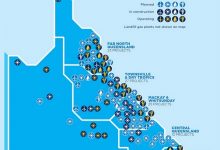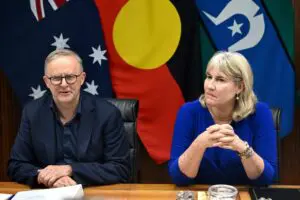Coal-dependent Queensland could meet almost 100 per cent of its electricity needs from renewable energy sources by 2030, a new report has found, if all of the state’s almost 15,000MW (15GW) pipeline of large-scale wind and solar projects went ahead.
The report, produced by Green Energy Markets for the Solar Citizens campaign group, says that if all projects under various stages of development in Queensland proceeded, they could generate more than 90 per cent of its forecast annual power consumption in 2030.
It points to a growth trajectory that has taken renewable energy capacity in Queensland from just 7.4 per cent of state electricity consumption in 2015, to 25.6 per cent – or just over one quarter – by 2020 (see Figure 2-1 below).
 “Since the beginning of 2016, 2,445MW of renewable energy projects (larger than a megawatt) have either become operational or been committed to construction,” the report says, adding that – for context – Queensland’s entire gas generating capacity is almost 2900MW and the coal fleet is 8,126MW.
“Since the beginning of 2016, 2,445MW of renewable energy projects (larger than a megawatt) have either become operational or been committed to construction,” the report says, adding that – for context – Queensland’s entire gas generating capacity is almost 2900MW and the coal fleet is 8,126MW.
By 2020 – based on projects under construction, expected uptake of rooftop solar and the projected outcome of the Queensland government’s 400MW renewable energy tender – renewable energy is expected to have grown three-and-a-half times above what it was in 2015, the report says.
 And with 15GW of big solar PV and wind projects in the development pipeline – which covers projects ranging from the early stages of site identification to those nearing financial close – there’s potential to sail past the state government’s target of 50 per cent renewables by 2030.
And with 15GW of big solar PV and wind projects in the development pipeline – which covers projects ranging from the early stages of site identification to those nearing financial close – there’s potential to sail past the state government’s target of 50 per cent renewables by 2030.
Not only that, but these 69 planned renewable projects awaiting approvals and investment decisions could inject $24 billion into the state’s economy and support up to 35,000 jobs.
 “The renewable energy power stations built or committed to construction in Queensland since 2015 will deliver $4.2 billion in investment with 5,687 construction and 273 ongoing full-time jobs,” said GEM analyst Tristan Edis, author of the report.
“The renewable energy power stations built or committed to construction in Queensland since 2015 will deliver $4.2 billion in investment with 5,687 construction and 273 ongoing full-time jobs,” said GEM analyst Tristan Edis, author of the report.
“If all renewable energy power plants being considered for investment were to proceed, the sector would generate six times more jobs and economic benefits to the state – that’s $24 billion in investment, 34,000 construction jobs, 1,500 ongoing full-time jobs.”
 But for this to happen, a range of obstacles would need to be overcome – and looming large among them is policy; the complete lack thereof at a federal level after 2020, and the lack of a policy roadmap at the state level.
But for this to happen, a range of obstacles would need to be overcome – and looming large among them is policy; the complete lack thereof at a federal level after 2020, and the lack of a policy roadmap at the state level.
“Even with about 2,500MW of additional capacity being converted from development to construction, the amount of renewable energy capacity in the development pipeline is almost five times larger than what it was in 2015 and now stands at just under 15,000MW (see Figure 2-3),” the report says.
 “The vast majority of these projects will only proceed to construction if there is new government policy to encourage further carbon pollution reductions in the electricity sector or the closure of existing power plants.”
“The vast majority of these projects will only proceed to construction if there is new government policy to encourage further carbon pollution reductions in the electricity sector or the closure of existing power plants.”
As noted above, Queensland has a nominal target of 50 per cent renewables on its grid by 2030, as well as for 1,000,000 solar rooftops.
To drive the large-scale market, it has pledged to drive 400MW of diversified renewables including 100MW of energy storage through a reverse auction, and claims to be facilitating planning and approval of projects, as well as advocating for stable policy.
Just last week, the Labor Palaszczuk government announced it had gathered $250 million from other clean energy programs to pay for the initial funding of its proposed CleanCo – a publicly owned clean energy generator.
The aim of this is to secure a cleaner, more affordable, sustainable and secure energy supply for Queensland, that the government says will drive down power prices by around $70 a year by increasing competition and investing in renewable energy sources.
But despite these policy measures – and a recent assurance from premier Annastacia Palaszczuk that she had “ruled out” any plans to build new coal-fired power generation in the state – the Solar Citizens report warns more is needed to ensure both the RET and the rooftop PV targets are met.
On rooftop solar, GEM estimates Queensland is on track to install close to the government’s capacity target of 3,000MW, but says the number of systems installed by the end of 2020 – forecast at close to 666,000 – falls short of the target for 1 million systems.
 To achieve that, the report says, would require a five-fold increase in system installation rates over 2019 and 2020 compared to what is currently expected to occur.
To achieve that, the report says, would require a five-fold increase in system installation rates over 2019 and 2020 compared to what is currently expected to occur.
And while installations of rooftop solar PV would continue, regardless – driven by consumers’ desire to take control of their power costs – the report warns there is no clear ongoing commercial incentive to install additional megawatt-scale utility projects after 2020.
Consequently – and not for lack of potential projects – GEM finds it “highly likely” Queensland will fall well short of its 2030 large-scale target, with renewables more likely representing under 30 per cent of electricity consumption, without new policy.
“Queensland’s high-quality sun, wind and water resources give us a major competitive advantage over other states and countries around the world,” said Solar Citizens Queensland spokesperson Louise Matthiesson in comments on Tuesday.
“Without strong, consistent and ongoing policy support for renewables, it is highly likely Queensland will miss out on many of these opportunities and fall short of reaching its target of at least 50 per cent renewable energy by 2030.
“Friday’s Clean Co announcement was a welcome step, but the state still lacks a clear renewable energy industry roadmap to harness this resource to create jobs and investment for regional Queensland.”










